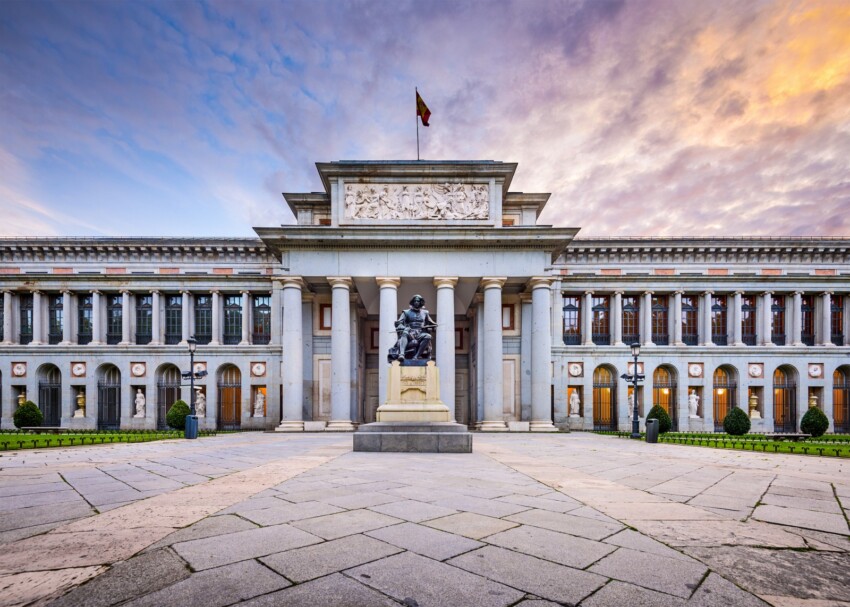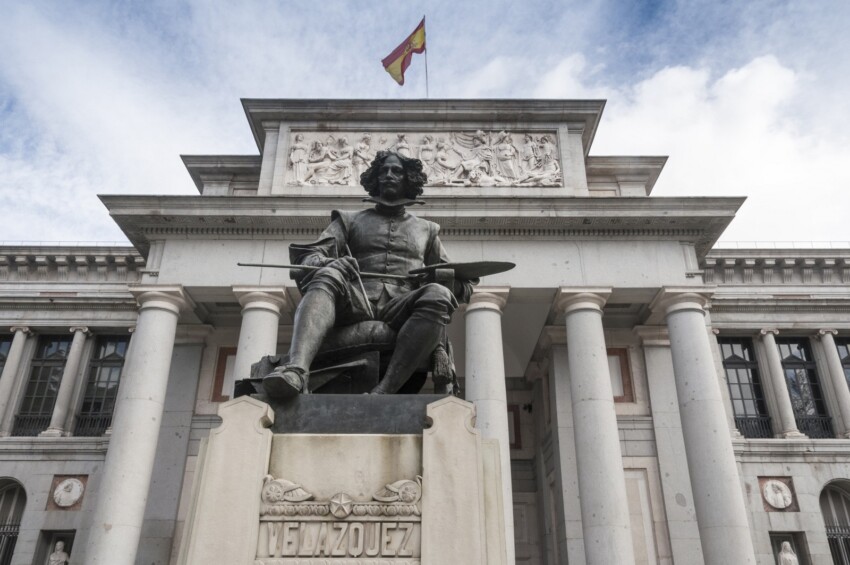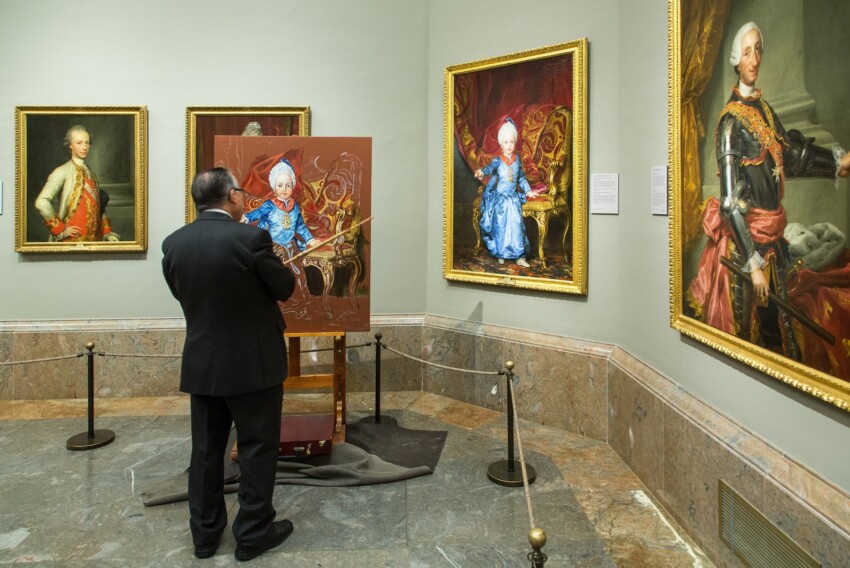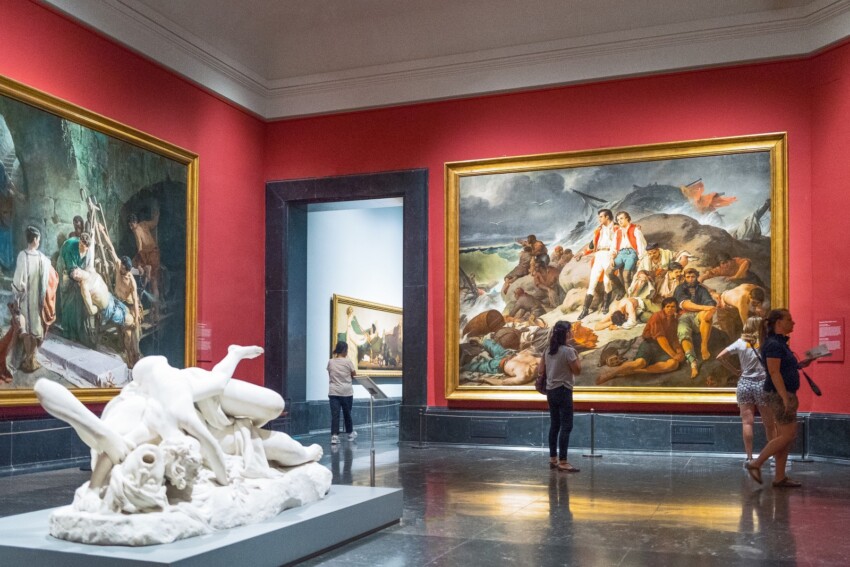
The Prado Museum is one of those tourist attractions that needs no introduction, being one of the most prestigious museums in the world: it fears no comparison with ‘holy monsters’ of art and culture such as the Louvre in Paris, the British Museum in London or the MoMa in New York.
A temple of Spanish painting, with the world’s largest collection of Spanish paintings from the 12th century to the 19th century, the Prado is also one of the best museums to admire Flemish painting and other masterpieces of European art.
A complete list of great artists exhibited at the Prado would be very long, we will just name Goya, Velázquez, Tiepolo, Titian, Dürer, Rubens, Rogier Van Der Weyden, El Greco and Bosch.
Whether you are an art lover or not, the Prado is a must-see on any Madrid holiday but the visit must be carefully planned because given its gigantic size, visiting the museum without an itinerary in mind could be a frustrating experience.
Turn a possible disappointment into one of the most fascinating experiences of your life: thanks to the information, tips, list of the most famous works and guided itineraries we have put together for you, you can plan when to go to the Prado, how long to stay and what to see, getting the most out of your visit.
The Prado is huge and how long to spend inside the museum depends only on your interest… and your stamina! Calculate a minimum of 2-3 hours to see the best of the Prado; an in-depth visit takes much longer.

The Prado Museum is housed in an elegant building of monumental dimensions designed by architect Juan de Villanueva in 1785 as a natural history museum.
It was King Ferdinand VII, on the advice of his wife Isabella of Braganza, who designated the new building as the Royal Museum, soon renamed the National Museum of Paintings and Sculptures and later the Prado Museum.
The museum opened to the public in 1819 with a catalogue that included “only” three hundred paintings, about one tenth of today’s collection!
The museum’s collection and the number of visitors have been growing steadily, reaching impressive growth rates in recent years. Suffice it to say that in 2016 it passed the three million mark with 3,033,754 annual visitors, but in the first six months of 2017 alone, visitors have already reached 1,726,962.
To cope with the demands of an ever-growing museum, the Villanueva building underwent modifications and additions, culminating in the construction of a new building connected internally to the original premises.
The most popular route to visit the museum is naturally the one that follows the various collections that make up the Prado’s artistic heritage.
Spanish painting is the protagonist of the museum, which was created with the intention of making the national artistic heritage known. The original core of the Prado collection consisted entirely of Spanish paintings; today, the Prado Museum possesses 2,000 Spanish paintings created between the 12th century and the end of the 17th century.
French and even more so Italian painting strongly influenced Spanish painting: fundamental to understanding the transition from the Middle Ages to the Renaissance, Italian art was the main source of inspiration for Spanish Baroque.
The scarcity of Italian and French paintings prior to the 16th century is explained by the Spanish monarchs’ lack of interest in collecting such works, but taste changed thanks to the influence of Titian, an artist much admired in Spain.

The Prado Museum has one of the most important collections of Flemish paintings in the world, with more than 1,000 works in the catalogue, thanks to Spain’s political relations with Flanders, united under one monarchy from the late 16th century onwards.
The museum can also boast the world’s largest collection of works by Hieronmyous Bosch, a Flemish painter who fascinated both contemporary and contemporary audiences with his vivid imagination and satirical tone. This exceptional collection is mainly due to King Philip II, who began collecting Bosch’s paintings a few decades after his death.
With more than 1,000 works mainly from Spain, Italy, France, Germany, England but also Switzerland, Russia and Poland, the Prado’s collection of 18th century paintings is a fascinating excursus into 18th century painting.
A key figure in this collection is of course Francisco de Goya, to whom we owe masterpieces such as Maja Desnuda y Maja Vestida, Saturn devouring his children and The 3rd of May 1808.
The collection of 19th century paintings is, paradoxically, the most extensive and the least known in the Prado Museum, consisting mainly of the works acquired by the Museum of Modern Art in 1971.
The artists who signed the neo-classical, romantic and historical works in this collection are mainly Spanish, but there is no shortage of important European artists.
The Prints, Illustrations and Photographs section of the Prado is the only one whose original nucleus is not based on the collections of Spanish monarchs, with notable exceptions such as the museum’s design by architect Villanueva, so emblematic that it was posted in one of the monarchs’ private rooms within the newly founded museum.
You will be able to admire drawings by Italian and Spanish artists, a collection of drawings, prints and letters by Goya, reproductions of works of art, photographic documents of the museum’s works and a collection of photographs of the Roman school dating back to the second half of the 19th century.
Little known to the general public, the rooms of the Prado dedicated to sculpture and decorative arts are no less interesting than those devoted to painting.
The Prado’s sculpture collection has almost 1,000 works, including sculptures from different periods of the classical world, a limited representation of medieval culture, Renaissance, Baroque, Neoclassical and 19th century works. The decorative arts collection includes miniatures, Flemish tapestries, porcelain, crystal, coins, medals and period furniture
Among the most important works in the collection are the Treasury of the Dauphin, Roman statuary and the works of the Lions commissioned by Philip II and Charles V.

Do you have little time and want to go straight to the most famous paintings or, on the contrary, do you have a lot of time and want to know where it is worth lingering a little longer? Here are the 10 must-see works at the Prado Museum.
Las Meninas is to the Prado what the Mona Lisa is to the Louvre: Diego Velásquez ‘s masterpiece is surely the museum’s most famous and admired painting. It is an innovative work depicting the ‘behind the scenes’ of a royal portrait featuring the infanta Margarita.
The meaning of the work is still debated; what makes this painting enigmatic, and consecrates it as one of the artistic masterpieces of all time, is the element of the mirror in which the king and queen are reflected. Are they observing or being observed? Decide for yourself while admiring this immortal work at the Prado Museum.
A work so beautiful that “it seems truly not of man, but made in paradise”: this is how Giorgio Vasari, an art historian and critic, defined the Annunciation by the artist Beato Angelico. A single work divided into two scenes: the expulsion of Adam and Eve from Paradise and the Virgin Mary receiving the Angel’s announcement.
The visionary imagination of Dutch painter Hieronymus Bosch reaches its peak in this highly original triptych depicting Eden, the Garden of Delights and Hell, populated by fantastic beasts and naked bodies engaged in grotesque scenes.
A proud artist’s self-portrait is the one made by the German Albrecht Dürer when he was already an established painter. The proud attitude and fine clothes denote the artist’s awareness of his own worth.
On one side is Paradise, on the other Hell: in the middle, attracting our attention, is a bright turquoise river ploughed by the boat of Charon, the ferryman of souls. The work is by Joachim Patinir, a Flemish painter.
Who commissioned Titian Vecellio to paint this highly erotic work? The commission of the painting is still debated, while the subject leaves no doubt. The Italian artist has depicted here the mythological episode of Jupiter seducing Danae by turning her into drops of gold, with the complacent young woman welcoming him into her languid body.
The destructive force of death, with which human beings are destined to struggle without hope of victory, is depicted by Flemish artist Pieter Brueghel the Elder in this extraordinary painting that merges two iconographic traditions: the Nordic dance macabre and the Italian dance, with clear references to the Palermitan school.
The representation of the biblical episode of the young David slaying the giant Goliath becomes in Caravaggio ‘s work a masterpiece of chiaroscuro used as a narrative element that enhances the dramatic nature of the representation.
Who is the Spanish aristocrat portrayed by El Greco in his most famous painting? Critics seem to agree today that it is Don Juan de Silva, notary of Toledo, but in the past the names of the writer Miguel Cervantes and the author himself have been mentioned.
This is also a painting you have surely seen in school books, magazines, websites: the resistance of the Madrid troops to the French army during the 1808 occupation of the Spanish War of Independence depicted by Goya is the image-symbol of the fight for freedom and the will not to surrender to tyrants.
An original idea is to visit the Prado following a themed itinerary that you can build based on your interests or curiosity:
The Prado Museum is among the most famous tourist attractions in the world and attracts an impressive number of visitors all year round.
Queues at the entrance are always long and can be nerve-wracking. Don’t let such mishaps spoil your visit to one of the world’s most beautiful museums: play it safe and buy your priority ticket online. It is the only guaranteed way to skip the queue at the entrance.
Alternatively, to discover everything about the Prado Museum you can have an expert guide accompany you on your visit. The cost is slightly higher than the entrance ticket and even buying this tour will save you time by avoiding queuing at the ticket office.
The Prado is part of the Paseo del Arte, a cultural itinerary in the city of Madrid that includes three outstanding museums such as the Thyssen-Bornemisza, the Reina Sofía and the Prado within one kilometre, plus other interesting museums, institutions and buildings. With the ticket below, you can purchase admission to all three museums at a reduced price.
The Prado Museum is open all year round, except on Christmas Day, January 1 and May 1; on other holidays it operates reduced hours.
It opens at ten o’clock in the morning and closes in the late afternoon. You can spend an entire day here without getting bored! The last two hours of opening hours are free for the permanent collection and discounted for temporary exhibitions.
There are two ticket offices at the museum, both in Plaza Goya, along Calle Felipe IV, and four entrances: Puerta de los Jerónimos, Puerta alta de Goya, Puerta de Murillo and Galería Jónica Sur.
Numerous services are available to make your visit to the museum more pleasant and comfortable, including:
The Museo Nacional del Prado is located along the elegant and shady Paseo del Prado. It takes about 15-20 minutes to get there from Puerta del Sol by walking east along the Carretera de S. Jeronimo.
Alternatively, if you are coming from a different part of Madrid, the nearest metro stops are Banco de Espana on line 2, to the north in front of Fuente de Cibeles, Anton Martin on line 1, to the west next to the market of the same name, and Estacion del Arte, also on line 1, which borders Paseo del Prado to the south. Whichever stop you choose, allow about a 10-minute walk.
Practically in front of the Prado museum there are three excellent hotels, part of the international chains Radisson Blu, NH and Mercure. There are also a number of hostels, bed and breakfasts and flats, both along Paseo del Prado and in the adjacent streets, such as Calle de Cervantes, Calle de Lope de Vega, Calle de las Huertas and Calle de Moratin.
The Prado Museum is located along Paseo del Prado, just east of the Retiro Park, in Barrio de Las Letras, just south of the Thyssen-Bornemisza Museum.
City Card allow you to save on public transport and / or on the entrances to the main tourist attractions.
